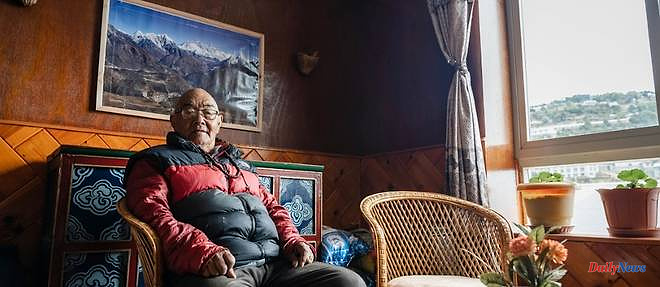90-year-old Kanchha Sherpa from Nepal is the last survivor of the expedition led by mountaineers Edmund Hillary and Tenzing Norgay Sherpa, who first conquered the world's tallest mountain, Everest, in 1953.
His journey to fame had started in the opposite direction, when as a teenager he fled his village Namche Bazar, now the biggest tourist hub on the way to Everest Base Camp, and reached the Indian mountains of Darjeeling. .
The 19-year-old found his compatriot, Tenzing Norgay Sherpa, settled in the region, who employed him as a handyman.
At the time, it was the starting point for Himalayan expeditions, Nepal having only recently opened up to foreigners.
A few months later, he returned to his native region, enrolled in the expedition led by the New Zealander Edmund Hillary and Tenzing Norgay Sherpa, for only a few Nepalese rupees (a few euro cents today) a day.
First meeting in Kathmandu, the members of the expedition then reached the base camp after several days of walking, evolving in sight on the sides of the immaculate mountain. Today, mountaineers follow a route already mapped out by experienced Nepalese guides.
Without ever having been trained in mountaineering, Kanchha Sherpa climbed to more than 8,000 m of altitude on Everest.
Now 90, weary and unable to speak to AFP, he said he was "the happiest (of men) when Tenzing and Hillary reached the top". he claimed, quoted by his grandson Tenzing Chogyal Sherpa over the weekend.
With clothes too big for them, provided at the time by the British expedition organizers, their backs loaded with tents, equipment and food, the Nepalese Sherpas climbed ever higher to establish camps, singing, s remembered the old man.
Seven decades later, hundreds of people reach the 8,849m summit of Everest each year and thousands more travel to Nepal to view the breathtaking Himalayan sights.
The mountaineering industry, which today weighs several million dollars, is based on the experience of the "sherpas", the mountain people of Nepal. They pay a heavy price to accompany hundreds of mountaineers each year. A third of the dead on Everest are Nepali climbers.
“Tenzing and Hillary opened our eyes and made development possible here,” Kanchha Sherpa told local channel YOHO TV in 2019, “life was very hard before. There was no way to earn a living.”
A direct witness to the transformation of the Everest region, Kanchha Sherpa continued his ascents for two decades, until his wife asked him to stop his dangerous journeys.
"Since (the feat on) the summit of Everest, tourism has increased exponentially," he said according to his grandson, "thanks to this, our way of life has changed, just like our income".
The education of Sherpa children is the most significant benefit, the former mountaineer stressed.
"They now have the opportunity to study and can, as a result, become whatever they want, doctor, engineer or scientist like my grandson," he continued.
"I never imagined such a thing was possible in my time. It's a benefit of the growth of tourism and mountaineering," he added.
The old man runs a foundation that bears his name, dedicated to families who cannot afford to send their children to school.
But he fears, despite everything, that "the Sherpa youth will be too influenced by Western culture and will slowly forget the Sherpa culture and language".
Nepalese mountaineers, mostly of Sherpa ethnicity, have always accompanied expeditions aiming to conquer Everest, ever since the first attempt to climb the roof of the world in the 1920s by a British team.
29/05/2023 09:58:13 Namche Bazar (Népal) (AFP) © 2023 AFP












